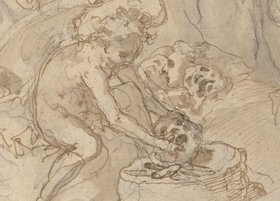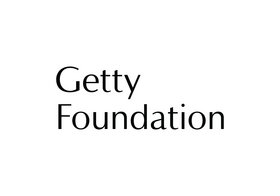Italian Drawings of the Sixteenth Century
- Project organizer Staatliche Kunstsammlungen Dresden

As one of the museums most steeped in tradition and most wide-ranging concerning the specialization in Art on Paper, the Dresden Kupferstich-Kabinett possesses a collection of Italian Old Master drawings of international stature. Not least among their holdings is a vast range of works from the high and late Renaissance era.
The collection includes more than 600 single sheets, as well as six bound volumes containing another 600 drawings of Italian draftsmanship from an era that spans across the 16th century. Among these items are world-renowned sheets, as well as a wide variety of high quality works that are as of yet mainly unknown to both scholars and the general public.
Since its inception in 2017, the project is dedicated to the research and cataloguing of this important inventory (see here for more material). In terms of its content, it serves as a follow-up to the collection catalogues of Italian drawings from the 15th century published in 2006 and 2014, which already featured some of the early works by 16th-century artists.
With respect to methodology, and with the wealth and diversity of the material in mind, we lay particular emphasis on fostering a dialogue with international colleagues. Since 2018, the project has been generously supported by the Getty Foundation as part of the initiative "The Paper Project: Prints and Drawings Curatorship in the 21st Century".
While researching the holdings, we have already focused on the digital publication of the drawings in the Online Collection of the Staatliche Kunstsammlungen Dresden. Almost all relevant sheets are now searchable online; in many cases they include a short commentary summarizing the state of knowledge. The data changes dynamically as the work progresses. We have deliberately included sheets still in need of thorough research, as well as works from the early 17th century.
A dedicated website designed by the project’s research assistant Heidi Lachmann and programmed by Martin Zavesky bundles the entries from the online collection into smaller topical units, inviting visitors to browse. In addition to regional schools and cities, the webpage offers various thematic areas. Further groups of works will follow over the course of the project.
Hints and suggestions concerning the artworks in the online collection are always welcome, and may be sent by e-mail or via the feedback function at the end of each entry.
Additional data, findings, tips, and thoughts on the drawings in Dresden that result from the dialogue amongst the project participants and other experts in the field are continually documented in the museum’s database and are available to researchers upon request. Beyond the data available via the Online Collection, we utilize a special format for digital research discourse, allowing participants to receive regular – password protected – updates on the progress of the cataloguing. In addition, they may also submit comments and suggestions.
The Exhibition
A selection of approximately 100 sheets was presented to the public from October 2018 to January 2019 as part of the “The Realm of Possibilities. Italian drawings of the 16th century” exhibition, co-curated by Gudula Metze and Marion Heisterberg. The exhibition included numerous unpublished artworks and some new discoveries.
The title “The Realm of Possibilities” referred both to the central role of these drawings in the development of pictorial ideas and to the freedom that the medium offers as an independent art form. Further, the never-ending process of the attribution and classification of Old Master drawings, which the title also alludes to, should be made comprehensible and transparent for the public. Since these interpretations of drawings, like the drawings themselves, are always influenced by temporal context, the exhibition also focused on acquisition and collection history, which spans more than four centuries.
A fan-fold brochure released on the occasion of the exhibition offered an additional overview of both the collection and its acquisition history. This publication was produced with the kind support of the Wolfgang Ratjen Foundation.
Workshop and Traveling Seminars
The exhibition also provided the setting for an international workshop. Senior specialists came together with early and mid-career professionals to discuss the Dresden collection of 16th-century Italian drawings, where they also debated current questions of curating prints and drawings. Another topic concerned the challenges of cataloguing complex inventories in the digital age.
Funding for the workshop was provided by the Wolfgang Ratjen Foundation and by a major grant from the Getty Foundation as part of “The Paper Project: Prints and Drawings Curatorship in the 21st Century”.
The Getty Foundation grant also supported the group of early and mid-career professionals in the form of two traveling seminars. During the first seminar in winter 2018, the participants visited collections in Leipzig, Berlin, and Budapest. In June 2019, a second seminar took place in Frankfurt and offered insight into the important collection of Italian drawings in the Städel Museum. Day trips to collections in Düsseldorf, Darmstadt, and Stuttgart completed the programme. This approach provided ideal opportunities for scholarly exchange and allowed a new generation of curators to deepen their knowledge of curatorial practice.
Curatorial Research Fellowship at the Bibliotheca Hertziana in Rome
The three-month curatorial research fellowship at the Bibliotheca Hertziana - Max-Planck-Institut für Kunstgeschichte in Rome proved to be highly beneficial for the scholarly examination of the sheets, as well as the preparation for the second project phase. The fellowship allowed Marion Heisterberg to use the institution’s exceptional research infrastructure while expanding the discourse concerning the Dresden sheets with colleagues on site (01.07.–30.09.2019).
Team
The director of the Dresden Kupferstich-Kabinett, Stephanie Buck, conducted the program by in cooperation with curator Gudula Metze, and with Chris Fischer (Copenhagen, Statens Museum for Kunst, Center for Advanced Studies in Master Drawings) as Senior Mentor, and Heiko Damm (Mainz, Johannes Gutenberg Universität) serving as Academic Advisor.
In addition, Marion Heisterberg, through her work as Project Coordinator for the colloquium and the first traveling seminar, contributed substantially to both the conception and the execution (01.06–31.12.2018). The second traveling seminar profited considerably in regards to content and organization from the work of Christoph Orth, who joined the project team as an assistant curator (01.04.–30.11.2019).
Duration
February 2018 – December 2019
Building on the experiences of the first project stage, the focus is now on cataloguing the Italian drawings of the 16th century. This process will involve art historical approaches, including provenance and collection history, as well as art technological research on the materiality of the drawings.
Thanks to the renewed support from the Getty Foundation, as part of “The Paper Project: Prints and Drawings Curatorship in the 21st Century” initiative, it is possible to build on the foundation of a broad scholarly exchange and to involve colleagues from various disciplines for both cataloguing and methodical debate. A key aspect here is the question of what form the future catalogue should take.
Exploring the holdings
As an indispensable basis, the systematic description of the drawings and the transcription of the associated archival records stood at the beginning of the second project phase. As a Predoctoral Fellow, Lisa Jordan filled in the large gaps in the documentation and supplemented the state of knowledge on the individual sheets in the museum database "Daphne".
We owe further new findings also to the close collaboration with Johanna Ziegler and Olaf Simon from the paper conservation department of the Kupferstich-Kabinett, where the drawings are examined with regard to their material condition and , if necessary, undergo conservation treatmente. For the scientific analysis of selected works, the team also received collegial support from Carsten Wintermann and Uwe Golle from the Klassik Stiftung Weimar.
Workshop
A central event of the second project phase was the international workshop that took place in March 2021. As a Postdoctoral Fellow, Christoph Orth was instrumental in organizing this three-day event which, due to the Covid19 pandemic, was held online. The workshop had a dual function: the participants discussed both concrete challenges in dealing with the Dresden holdings of Italian Cinquecento drawings and fundamental questions of cataloguing in the digital age.
Colleagues from different institutions and career stages shared their experiences. The guest list included the teams of other cataloguing projects funded by the Getty Foundation’s Paper Project Initiative (Program, Speakers & Topics). A more detailed report on the conference is in progress.
Studiolo
In order to promote exchange, we initiated a series of informal virtual meetings on individual groups of drawings and questions of classification under the title "Studiolo". We first held two rounds of discussions on particularly controversial or hitherto completely ignored sheets that aredifficult to classify (see the drawings selected for "Studiolo I" in June 2021, and those for "Studiolo II" in September 2021).
Short Term Visiting Fellows
The second "Studiolo" took place during the visit of the four so-called Short Term Visiting Fellows to the Dresden Kupferstich-Kabinett. Together with mentor Chris Fischer, the participants discussed selected groups of works and considered possible classification approaches. The four fellows (Alessandra Nardi, Florence; Annkatrin Kaul, Mainz; Elena Rame, Novara; Anita V. Sganzerla, London) accompany the project with their expertise. They will also participate – together with other international scholars – in the cataloguing.
Catalogue
The developing catalogue is planned to be released digitally in pdf-documents freely accessible to the public. It is organised according to local schools and thus follows a traditional concept that, despite all methodological challenges, has proved to be a useful basis for our work.
The publication of the digital catalogue is scheduled for 2023/24, followed by a printed catalogue containing a selection from the holdings.
September 2019 - December 2023
Gudula Metze, Curator for Italian, French, and Spanish Drawings and Prints to 1800, Kupferstich-Kabinett
Director of the Kupferstich-Kabinett
Stephanie Buck
Project Staff at the SKD
Lisa Jordan, Predoctoral fellow, Kupferstich-Kabinett (01.03.–30.04.2021)
Christoph Orth, Postdoctoral fellow, Kupferstich-Kabinett (01.09.2020–30.09.2021)
Silvia Massa, Postdoctoral fellow, Kupferstich-Kabinett (since 01.06.2022)
Heidi Lachmann, Research assistant, Kupferstich-Kabinett (since 01.01.2020)
Olaf Simon, Paper conservator, Kupferstich-Kabinett
Johanna Ziegler, Paper conservator, Kupferstich-Kabinett
Mentorship
Chris Fischer, Kopenhagen, Statens Museum for Kunst, Center for Advanced Studies in Master Drawings
